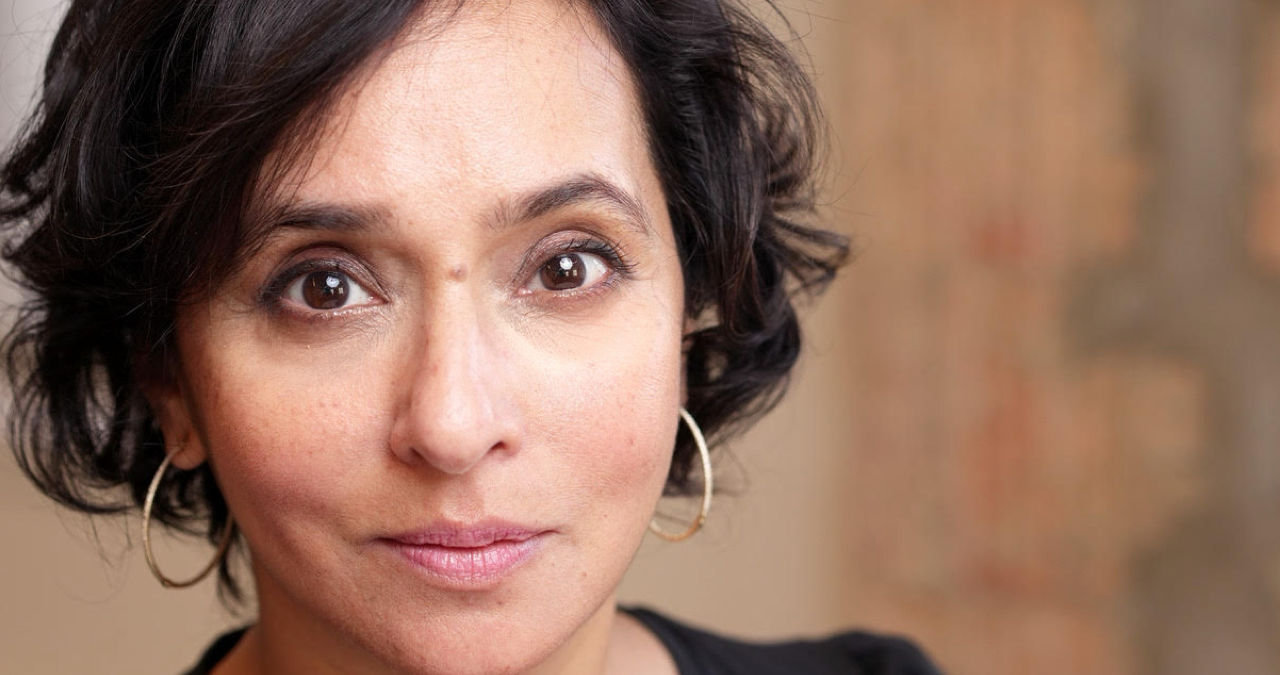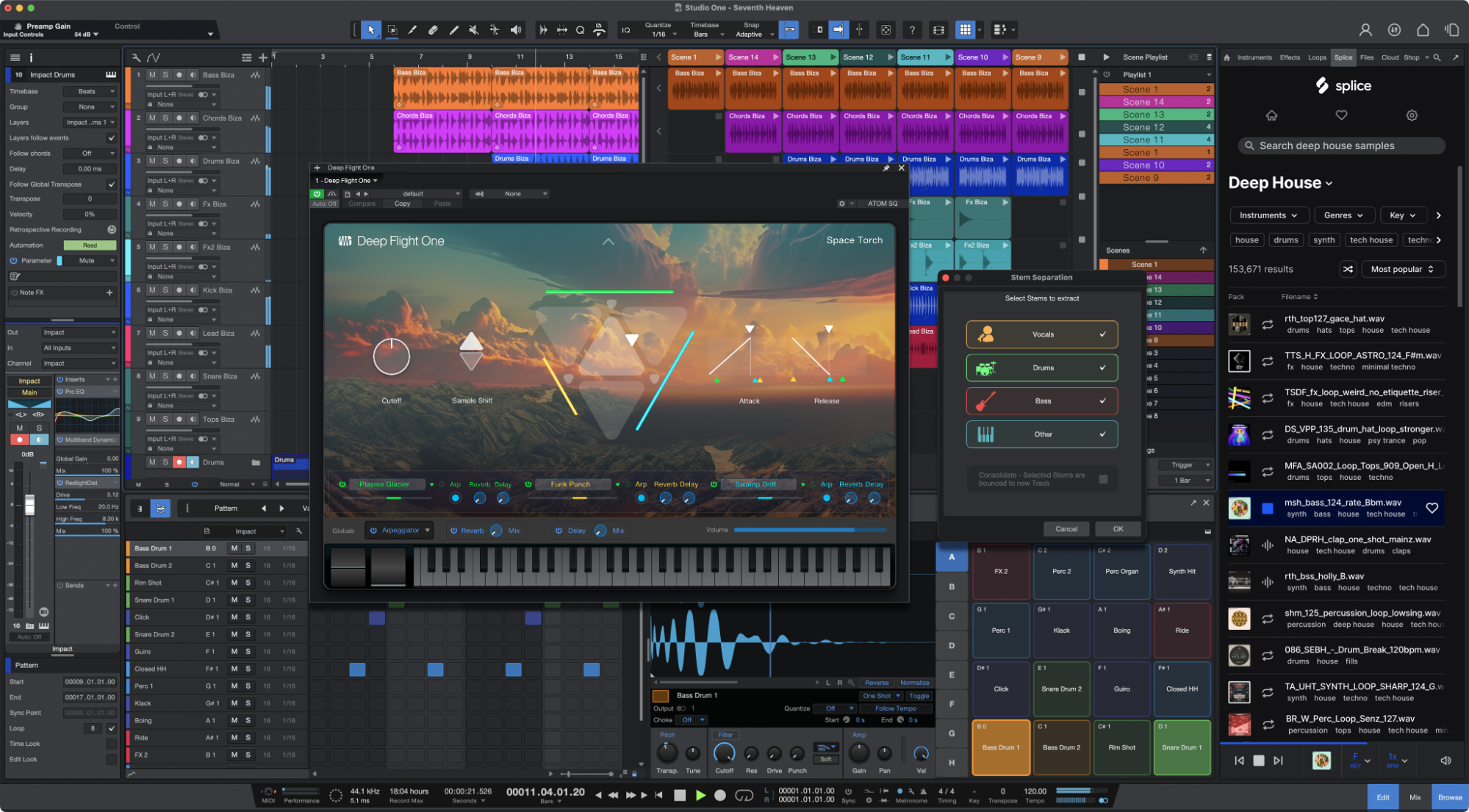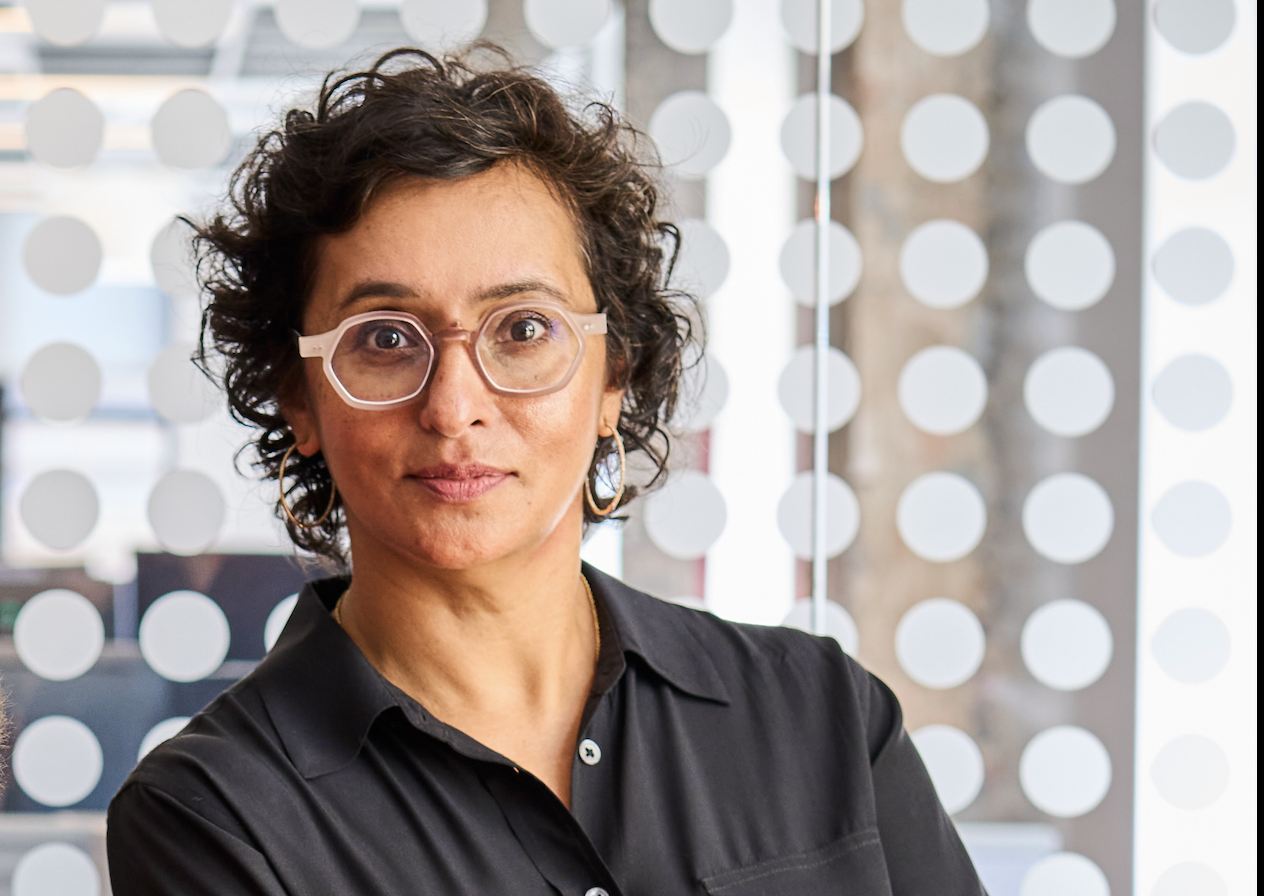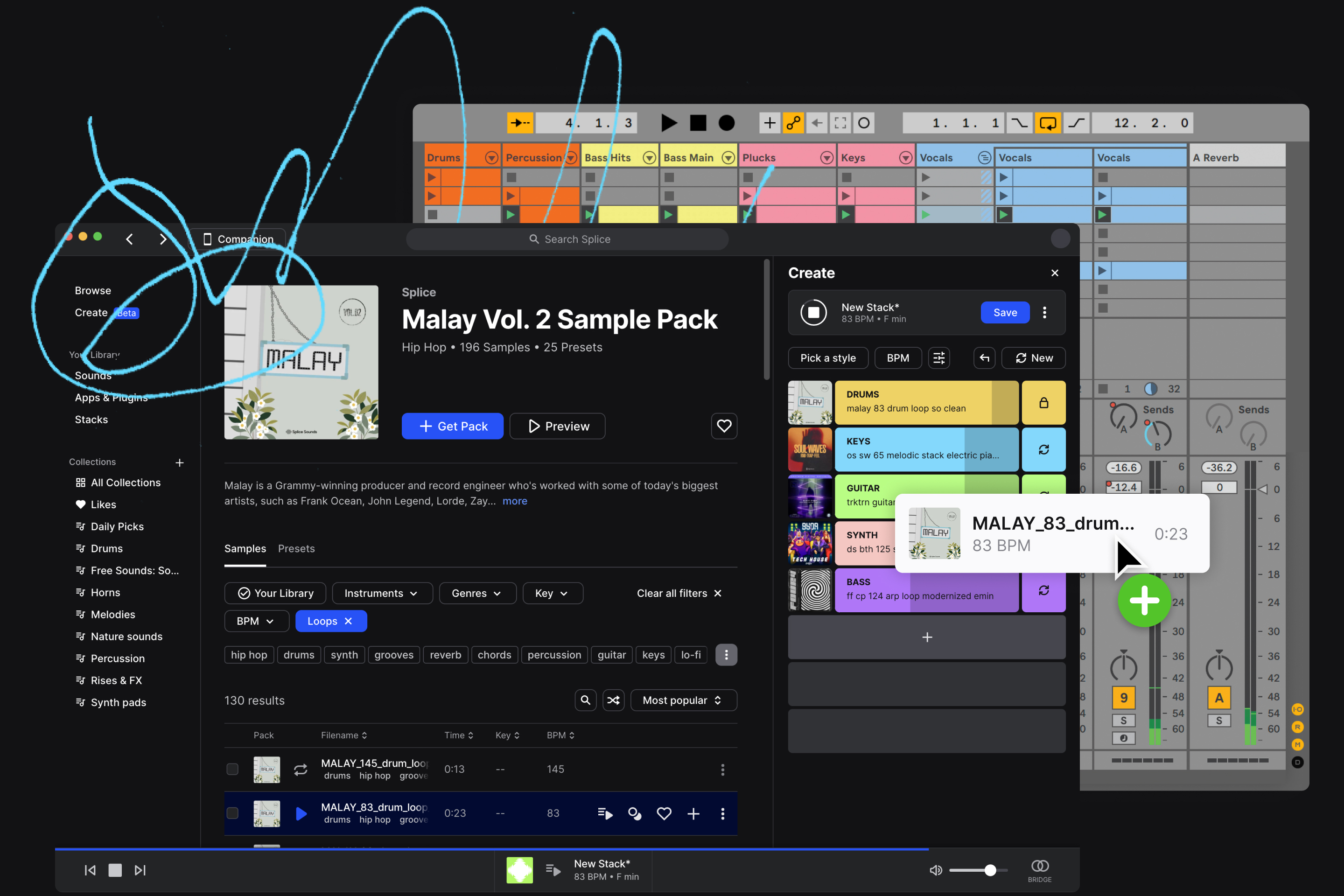
Increasingly in 2024, discussions around what the future of music-making might look like heavily figure AI, and the haunting vision of creatives being supplanted by artless algorithms. While many key figures like Spotify’s Daniel Ek might suggest that the cost of creating content is ‘next to zero’, Splice CEO Kakul Srivastava is currently leading the counter conversation, positing a more human-centered view of AI.
In Srivastava’s view, AI will serve the next generation of creators as both compositional aid, and organiser of the vast repository of over 2 million samples that Splice has accumulated since its inception in 2013.
These aren’t just ambitious future-facing plans. Today, Splice has announced its first major DAW integration with PreSonus’ Studio One Pro 7. This integration allows users, in their project workflows, to ‘Search with Sound’. What this means, ostensibly, is that an invisible team of algorithmic assistants get to work rifling through Splice’s acres of digital shelves in search of suitable complementary material that would suit an artist's tracks. It's a matchmaker, for human-crafted arrangements with human-crafted samples.
Formerly the Vice President of Creative Cloud Experience and Engagement at Adobe, and Vice President of Product & Marketing at GitHub, Kakul has helped shape much of the tech which is now pivotal to the modern tech world. We spoke to Kakul about both the new integration, and Splice’s vision for the future…

MusicRadar: Hi Kakul. Can we start with you giving us a brief overview of how the new Splice integration with Studio One works and, why you wanted to collaborate with with PreSonus in the first instance?
Kakul Srivastava: “Maybe I'll start with where we usually start, which is with our customers. I've been here as CEO of Splice for about two and a half years. Most of my career has been about building tools for creative people. I'm new to the music world, but I've been building software for creative people all my life, and for me, especially, being an outsider to the music world, my first thoughts were; ‘how do we spend time with customers?’ and ‘how do I get to know what their needs really are?’
"We've been building our AI technology around the Create experience for some time. And, as we started to put those experiences out there, the response was very positive. People love being able to start with any sample and build a whole stack of music around that.
“Our [AI] algorithm is clean, from a rights perspective. It's not trained on content that we don't have access to. What was missing for users was they want to be they wanted the Splice ecosystem closer to their workflow. The question was, how do we bring this content closer to our creative work? We've invested a lot in our own desktop application. It’s common to visit producers today and when they're working you'll see their DAW open, and you'll see Splice open right next to it. So we started trying to answer that question of how do we do it even better? How do we get even closer?
“I had a conversation with Andy [Mooney] the CEO of Fender on how we could potentially work together and what can could do. As we started brainstorming, we realised that perhaps we could do something with PreSonus. The teams got together, and they were really excited to work together.
“We're pretty proud of what we're launching. [It's great] to see the faces of our customers when they see how the integration works, and how we're able to sort of be part of the creative process, and almost be an assistant to the producer - right in their workflow. We can listen to what they're working on, we can 'Search by Sound' to provide them the right content, right in line with what they're doing. That's just incredibly powerful.”

MR: While that certainly benefits Splice subscribers, users without a subscription also get a batch of curated samples, right?
K: “Yes, we really wanted to make sure that with this integration, regardless of whether you have a relationship with Splice today, you would get some value, and you would immediately be able to see the power of the integration. It was important for both companies to deliver that right out of the gate. Of course, if you are a subscriber, you have access to our full library, and that just gives you so much more creative freedom.”
MR: While Studio One sound like a natural first integration, would you consider further integrations with other DAW-makers, like Ableton or Bitwig?
K: “That is definitely something we're going to be doing. The collaboration we have with PreSonus has been absolutely tremendous, but we know for sure that users really, really want this capability in their own creative workflow, wherever that is. I can't name names at this stage, but there are certainly other partners who are super interested in bringing this same power to their users. You will definitely hear some news from us next year…
“People often start their creative process with Splice, which is surprising, because you sort of think ‘Oh, Splice is just an ingredients place, right?’ But just like if you go to the farmers market, and look at the vegetables, you might not know what the vegetable is, but you decide you’re going to figure out how to use it.
“I think it's a similar experience where people will go to Splice and listen to some options, then they will maybe take their creativity in different directions based on what they’ve heard. That's really a great experience for them. We also really like the idea of starting with sound. We launched an experience earlier this year in which we basically allowed users to drop their own musical idea into Splice, and our software will build a Stack around that.”
“Now that we can do that inside your creative workflow, you could imagine how that's just so much better, because you're in there, you're working with your own musical idea, your own track, and then Splice is right there, kind of assisting you with the next parts It just feels like this is the right way to work.
MR: Driving Splice’s ‘Search for Sound’ integration are AI algorithms that are trained to find corresponding samples. AI is obviously a bit of a hot potato right now in the tech conversation, but as it stands, what you’re doing is using AI in the service of connecting real people with other people’s samples?
K: “100%. There is a lot of fear-mongering going on, and honestly, I think there's a lot of misuse of AI technology. I think there's a lot of irresponsible use of technology. As a technologist myself, I find it offensive. People should respect the rights of creators, and I think people should train [AI] responsibly. I think artists should be fairly compensated for their work and the model of typing some words and getting a song out is not helping the creative workflow – it’s replacing the creative workflow.
“That's not what our users want. It’s not what the people we serve want, they want their creativity to be front and centre. I just think that AI has such power to [do that]. It's just harder. It's harder to do it this way. It's harder to put creators in the centre. It's harder to give them more creative control. But it's worth doing.”
“I went for a run this morning, I don't want Nike to invent a robot that [runs for me] right? I want them to use AI to build a better shoe for me, because I want them to be able to understand that, you know, I move my knee in slightly the wrong way, and that's gonna hurt me.
“An artist was telling me the other day, that ‘I don’t want music to make my music for me, so that I have more time to wash dishes!’”
MR: I guess what you've said kind of implies the answer to this question. But would you say that yourself - and Splice - see AI more as a creative liberator, as opposed to an existential threat for music-makers?
K: “It's not even a liberator. I see AI as a creative empowerer. I see it as something that super-powers creatives. It helps them find the right sound faster. It helps them explore different artistic directions more quickly.
“I’ll never forget one of the pieces of user feedback that we got when we were first launching Create. The biggest button in the user experience was feedback. [Many people] wrote in to say that they didn't think they could actually work in a particularly genre, but they actually can, and it's been such an unlock for them.”
“That [gets to the nub] of my idea of what AI can do. It can unlock and enable you to explore these new creative directions that you didn't think you had permission to play in before, but now you can. You might be a hip-hop producer, you might not want to do lo-fi or a cinematic music, but the fact that you can explore it, the fact that you can learn it, and you can bring those learnings to your own work, I think, is really, really important. I like that it’s sort of enabling creators to do more.”
MR: How engaged are you guys with your community? and how important is nurturing that relationship?
K: "It’s central to everything we do. Every time I meet someone who says, ‘I have a nephew who does this’ or ‘I have a niece who's doing this, or have a daughter who's into music.’ I want to talk to them. I spend a portion of my day talking to customers, it’s really important for me to do it personally. We do a quarterly NPS survey. We look at every single comment through social media. We have a large Discord community that we work with very closely. We don't always get it right, you know but we want to stay responsive to our audience.
MR: Conversations around Splice and about the sample subscription ecosystem in general can kind of provoke a lot of vigorous conversation. There was some fiery debate recently around artists like Fred Again, and Sabrina Carpenter basing a few of their tracks on notable samples from Splice, what’s your take on that?
K: "Everyone has a different creative process. I also like to think about it as a conversation. I mean, you know, it's not like our samples are made out of a large manufacturing process or something like that. They're humans on the other side, they're artists who are crafting these samples. This is their life's work and and so when someone is using a sample, they know that there's an artist whose craft this was. So I see it as a conversation between the creators on both sides.
MR: With that in mind, would you ever consider using generative AI to build fresh sounds and samples in the future?
K: "I think there is power in these [AI] tools. But, I don't think the power in these tools is, ‘oh, we can generate a sample’. I think there's power in the human-generated samples that our users really appreciate.
“I do think that generative AI can be used to build better tools. We spend a lot of time with artists. I personally spend a lot of time with producers, learning about how they would want to use generative AI in their creative process. They've got some really powerful ideas. Are we working on it? Absolutely, absolutely, we're working on it. We're not going to use it to ‘generate’ a library of samples. We're going to use it to build better tools."

MR: Looking at the landscape of the sample world, a few people have muscled into that space in the last few years, but Splice remains the market leader. What do you think has been kind of central to that position enduring?
K: “Firstly, I feel extreme gratitude to our customers, because they're the ones who are allowing us to have that market leadership. I think there are two things that we spend a lot of our time and energy on, but I think it pays off for us. One is the craft that goes into building our catalog of sounds.
"We're just about to send a team of people to Sao Paulo to do a residency there. We're going to be spending a lot of time understanding the music culture there, getting to know artists on the ground, you know, what sounds they want to use, what sounds they are creating and make that a core part of our catalog.
"We've done the same in many other places. We've sent teams to Germany and Korea and India, Japan. We're constantly sort of scouring the world for the most authentic sounds out there. And, the people who do this work care deeply hear things in sounds that you and I could never hear. That attention to detail is really important. I think the quality bar that goes into the catalog that we provide is high.
“The second thing is that we spend a lot of time on is really listening to our customers about the experience and whether it's how we make search better, the new AI tools that we're working on. Even more simple things, like the feature that we launched recently called ‘Rare Finds’, people want something that's unexpected, something that other people haven't found. And using Rare Finds, you can get access to these things that are sort of underneath all the crate digging. I like that we continue to invest in that. I think those are the two things that we are probably more geeky about than most people, and I feel proud of it.”
MR: Where do you see Splice in the next ten years?
K: "I hope in ten years time, I'm having a very similar conversation with you. I hope that what's made the difference for us is that we just listen to our customers more deeply than anybody else. I hope that we are building ever more powerful creative tools for our customers. I hope that we are still at the centre of the creative process. I think those things are going to be fundamental for Splice.
“They're fundamental now, and they'll be fundamental ten years from now. I'd like us to have built much better tools because of the investments that we're making, and I hope that we've helped creators expand the methodology they have for bringing their ideas to life.
“I actually have very specific thought in mind. DAWs have been around for decades, and there's something about that timeline-based experience that resonates with people, that's very, very deep. But sometimes I wonder if that's the best way to make music. Sometimes, I wonder if there are new ways in that I think we should explore this with our DAW partners. I wonder if there's a way to explore new modalities for music creation.
"Perhaps we start with a sound first. I come from Adobe, so you can imagine a scenario where you have something like Photoshop, where you start with a blank canvas, and you bring all the pieces together that you work on your image. You can imagine another scenario which is maybe more of a Canva-like experience, where you start with content first, and you build around the content with your own musical ideas.
"These are big ideas, but I think there's evolution that needs to happen. I hope that with this partnership and moving closer to the creative workflow, that we're learning more and we're on the road to bring these new ways of creation to life.”
Head to Splice's website for more info on Splice's new integration with Studio One Pro 7.







